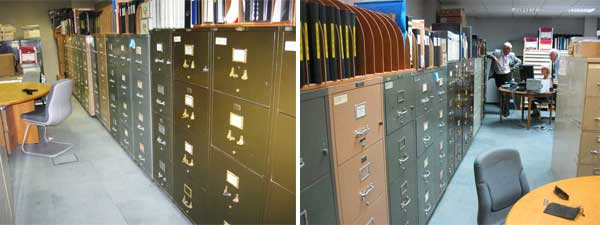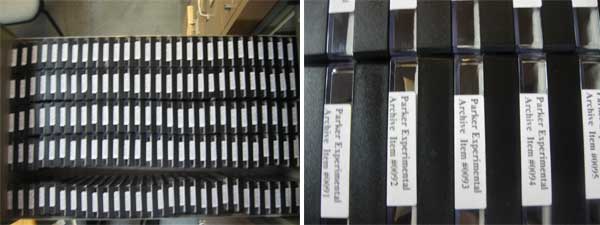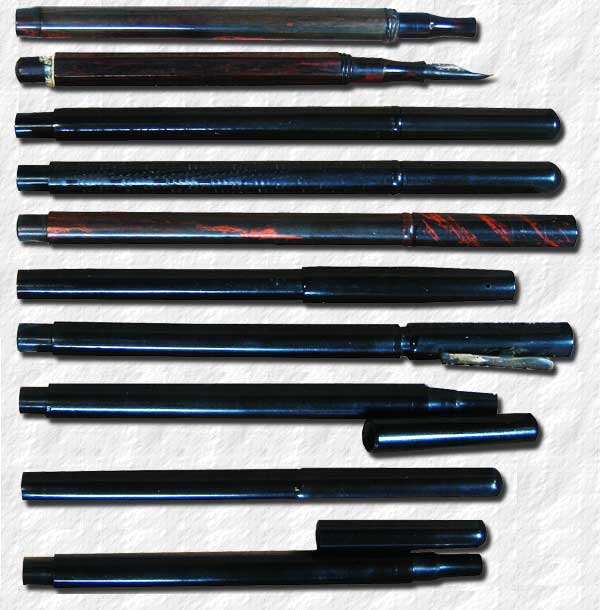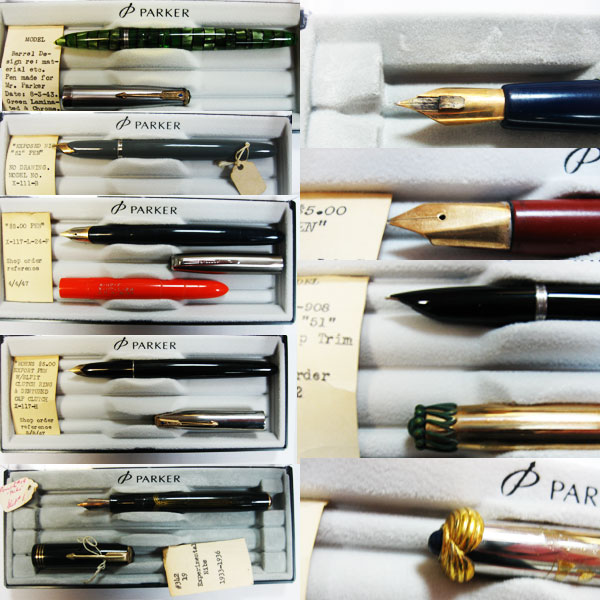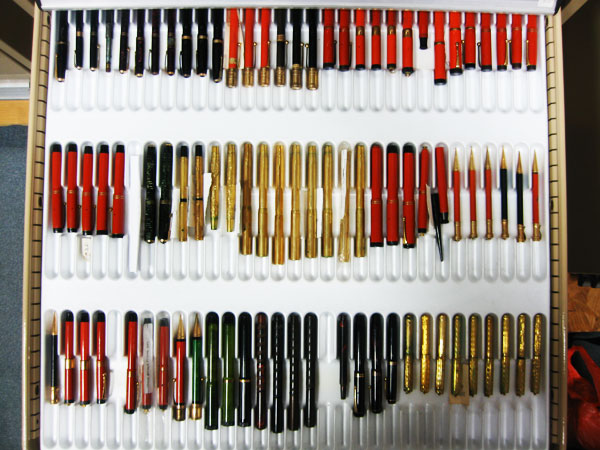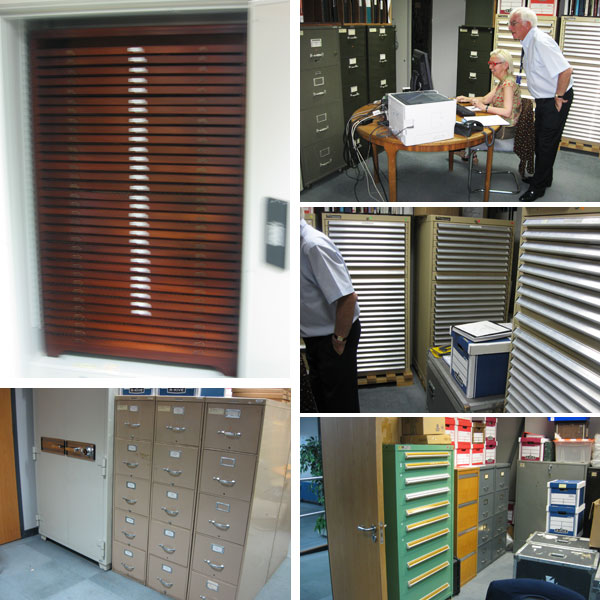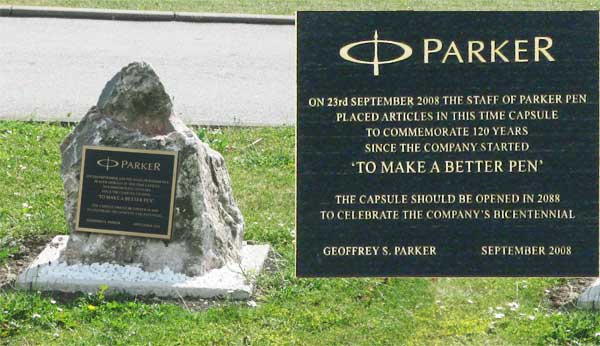
| parkerpens.net |
| PARKERCOLLECTOR.COM |
|
||
Well writing this I'm still having a hard time deciding which pen in the parker Archives is the Holy Grail. Maybe one of the Snakes, maybe one of the fantastic mother of pearl and abalone overlays, the "pregnant" Parker? Maybe a Pompeiian brown Duofold or a stub, striped Golden Arrow in blue? Maybe one of the solid gold Vacumatics, Parker 51's, 61's, 75's or Duofolds all on parade? You tell me. To each his own fantasy. I'm expected by Mr. Dave Ruderman who is the caretaker of the Parker Archives in Newhaven, well to tell the truth i doubt that there would even be any Parker Archives if it hadn't been for Mr Ruderman. The Parker company in the US bought Manpower in 1976 a venture that proved very successful, generating a lot more revenue than the pen division. A strong dollar and 75% of all Parker pens sold abroad, the Americans decided to sell the writing Instrument division. A group of directors for Parker in the UK decided to try a takeover. They initially went for the European Operations but this was turned down by Parker US. It was all or nothing, according to Malcolm Troak in his book Pen to Paper. Venture capital was obtained and the takeover took place in january 1986 but venture capitalists as major shareholders weren't really an option in the long run. |
At the time when the Parker Janesville factory was shut down Dave Ruderman was working in Boston. He got word that boxes and boxes, tons of spare parts and pens had simply been thrown away when repairs was moved to France. Nobody knew what was going to happen to the legendary archives. He decided that if nobody was going to save the archives he would do it himself. He took it upon himself to have everything, over a hundred years of company history, packed in a giant container that was first shipped to Boston and then to Newhaven. |
|
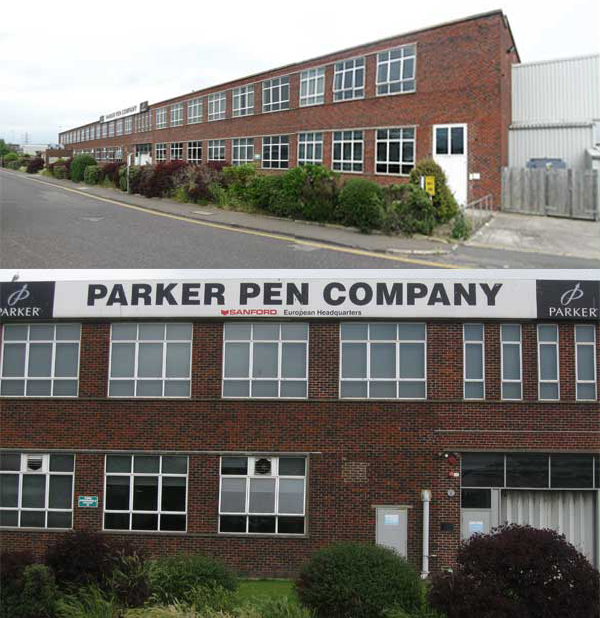 |
The façade of the "old" Parker building in Newhaven, UK. |
The Newhaven factory is a massive building on historic land. Already in 1921 a man named Felix Macauley started a pen factory on the site. The Valentine cards company was founded back in 1881 and they had later on diversified into pen making, having a small pen factory in London during the 1920's. In the 1930's they bought out Felix Macauley and began producing celluloid and casein Valentine pens on the site. Previously the Parker factory in Toronto, Canada, had supplied Europe with Parker pens and later with parts that were being assembled in the prestigious Bush House in London. |
Dave Ruderman knows the importance of tying together the past and the present. He has come up with ideas for many of the formidable pens made in Newhaven, and he's especially fond of the Special and Limited Editions. He was the driving force behind the Parker "51" Special Edition that was launched in 2002. When starting that particular project the container with the Parker Archives was still in transit and Mr. Ruderman needed the help of a Parker "51" collector to determine which features would translate well from the vintage "51" to the modern Special Edition. He turned to the well known Parker "51" collector Mr. David Shepherd, a retired dentist who nowadays shares his time between his family, golf and writing incredibly informative books about Parker pens. He is also the editor for the British Journal of the Writing Equipment Society. Mr. Shepherd has earned himself unlimited access to the Parker Archives. |
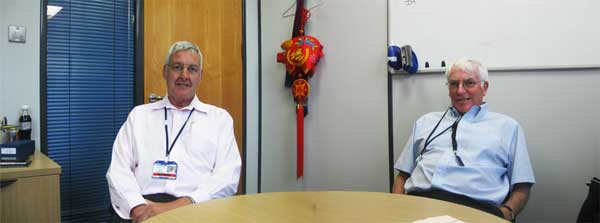 |
David Ruderman and David Shepherd. |
Mr. Ruderman and Mr. Shepherd is waiting for me when I have been let in to the premises by the guard and given a label with the words "Visitor Archive". It's a warm, cloudless day but I will have no problem with the thought of spending it in the closed confinements of a windowless room. The front doors have brass handles in the shape of giant Parker Arrows and we're in. I'm a bit surprised that everything seems so... ordinary. To me Parker has always been more than just a company making pens. There's no company in the world, my own newspaper included, that i know so much about. I have read almost everything there is about George S. Parker and his company, his family. I have even read excerpts from Kenneth Parkers diary and in learning all I could about the pens I have researched how plastics are made, I have read about metallurgy, the chemistry of ink, advertising strategies, fluctuations in the global economies and about other pen makers. I have learned about industrial design and I have been discussing all these things with other collectors around the globe. |
After being offered a cup of coffee to steady my somewhat shaking hands I am told the story of the Parker pen factory in Newhaven up until the recent changes. I learn of the problems with running a company in the midst of a recession and the anger about having lost ground to Montblanc just because previous owners was unable to fully understand the pen business, and because current owners have priorities that does not always include Parker. It's indeed baffling how hard it is today to find a Parker pen. Even customers who already decided on getting a Parker leave the stores with another brand just because the Parkers can't be found. You can't buy a Parker pen on the official site and even though there's a shop-finder there are no links to on-line sellers. Sad. |
|
TOP: Drawers. |
David Shepherd pulls out the first tray. Like I said earlier all pens aren't stored in chronological order, but this first tray contains the oldest ones in the Archives, dating from the late 1800's. Most are in fantastic condition but I'll soon learn that some pens have simply disintegrated during over a hundred years of storing. Especially some bakelite parts have crystallised, and a few pens have the appearance of cracked canes of sugar with black caps. Breaks ones heart. Later on I will even find a crystallised Vacumatic. There are some great early pens. Hexagonal, mottled pens, thin pens, short pens, huge pens and even the green mottled hard rubber pens that David Nishimura told me to look for. They are all wonderful. I am already looking at my watch. It's 9.30 AM. I'm glancing at Mr. Ruderman and Mr. Shepherd, wondering how long they will let me stay in here. |
"It would take six months to go through it all", he says. I'm guessing he speaks from experience. I realise that I need to prioritise. I am not allowed to take studio quality pictures but I have come armed with a new, fine compact digital camera. I hope it'll do the trick. I spent the night before in my room at the B&B practising on some pens i found in an antique shop earlier. But now, going to war, I can't get my weapon to work. Fortunately Sergeant Major Ruderman knows all about Canon cameras and with a few twists and clicks it's ready to go. Mr. Shepherd shows me a thick stack of papers where the pens in the safe are listed. The first boxes are very interesting from a historical point of view. Some are mottled but most are black, straight and with no trim. Sometimes only with small differences in sections or caps. There are some very beautiful aluminium pens in black, orange, yellow and blue. Soon a few red rubber Parkers make themselves known and in drawer number four they are. I'm almost hesitant to touch them. The Snakes. Yes, I know that dozens of pen manufacturers made snake pens and I know that even Parker offered snakes as a limited edition some years back. But these are the real thing. These are legendary. I can't belive that I'm standing here, holding both the silver and the gold Snake in one hand. The emerald eyes are looking at me as if to say "Please don't put us back in that dark old box. Buy us! Wrtite with us! Fat chance. |
|
Eyedroppers from the late 1800's. George S Parker pens, Silver Dollar pens, Palmer pens and New specials. |
I've seen images of some of them before. Like the fairly common #16 with gold filled overlays. |
I've always liked the mother-of-pearl and abalone pens, but this is the first time I've ever been fortunate to see them in real life. And they are truly stunning. Fantastic colours in the pearl. The #47 "Pregnant" Parker is smaller than I had imagined, but the design is really unique.
|
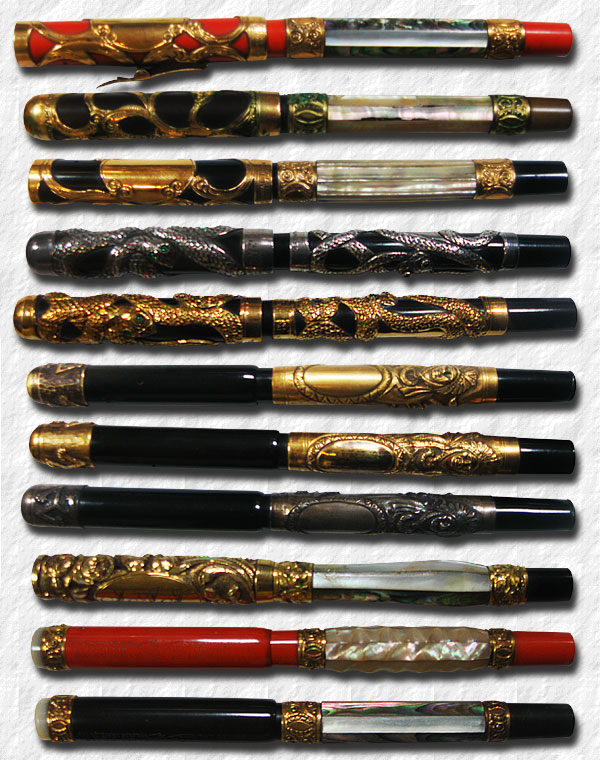 |
Overlays anyone? From the top: #15 Red Pearl, #15 Black Pearl, #15 Black Pearl Flat Cap, #37 Sterling Snake, #38 Gold Snake, #58 Aztek Gold ED, #58 Aztek Gold BF, #57 Sterling Aztek, #47 "Pregnant" , #45 Red Corrugated Pearl, and #45 Black Abalone and Pearl. |
The overlays disappear in the safe again and I stand there with a small sigh, feeling very lonely… Then Mr. Shepherd brings a whole tray of Duofolds in perfect colours. Black, Red, Blue, Yellow, Green, Brown, the Pearl DeLuxes and even six Pompeiians in different sizes, two without cap bands, four with. Wow again. |
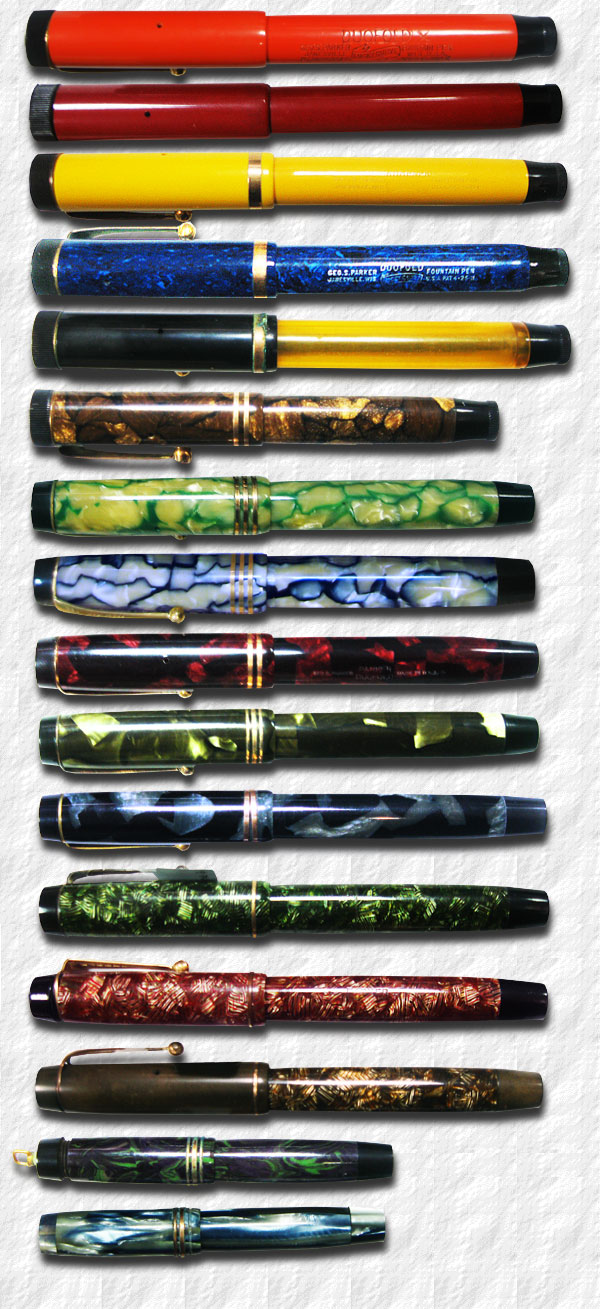 |
Vibrant Duofolds. |
At first I'm a little bewildered when I find a row of Duofolds with strangely coloured clip screws and blind caps, There are red Duofolds with green ends, Black ones with green ends, Green ones with green ends, Green ones with blue ends, Blue ones with blue ends. Then I realise what they are. It's the Parker Patrician. That's right folks, Parker also had a series called the Patrician. These pens were made from 1927 and was made from "inferior parts", that is reject parts from the Duofold production. They were stamped Patrician Fountain pen and were made both in the US and the UK. Aside from the standard Duofold finishes and sizes, they were also made from Pastel stock, with off-white, blue, red, or black ends. Some had clips, some had not, some had cap rings, some had not. There's a great collection here, but i suspect one can find just about any colour combination imaginable out there. |
|
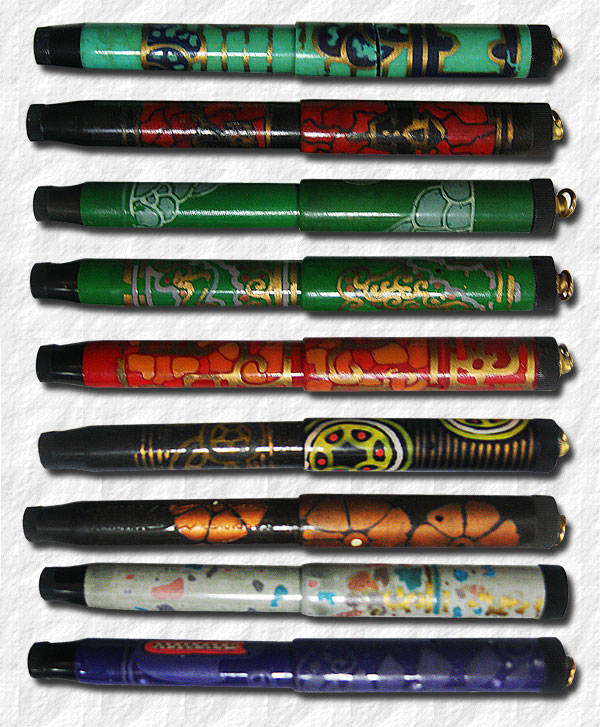 |
Some 1920's hand painted Ivorines. |
|
A very small selection of the thousands and thousands of experimental pens, details and prototypes saved in the Parker Experimental Archive. |
I take a look in a cabinet filled with old production catalogues from the 1800's and onward. The earliest ones has been bound into hardcover books. There are pamphlets, inserts, newpaper ads and all or most of the Parkergrams and other in-house publications has been saved. Letters, salesreports, Office memorandums, laboratory reports, You name it. It's all here. As us collector's quibble about when this and that was done to whatnot, the answer is in here somewhere. |
|
|
Kenneth Parker's Duofold. |
|
One drawer from the triplicate archive, |
|
LEFT: The Safe. Blurry because of hands shaking uncontrollably. |
June 2009 Addendum: In the summer of 2009 the workers at the Parker Pen factory in Newhaven were told by Newell Rubbermaid that the factory would be closed by Autumn of 2010. Most of the manufacturing which takes place in Newhaven would be moved to the company's site in Nantes, France. So far no final decision seems to have been made about the Parker Archives. |
|
The Parker Time Capsule in Newhaven. |
© 1995-2014 Tony Fischier and The Parker Pen Company®/Sanford Ecriture.
This page is in no way sponsored by or created by the Parker Pen Company®. All opinions, views, and thoughts expressed herein are expressly the authors, and in no way reflect the opinions, views, or thoughts of the Parker Pen Company®/Sanford Ecriture. All logos and/or images on these pages are © Copyright of Parker Pen Company®Sanford Ecritureunless otherwise stated and is reprinted by kind permission. If You feel that Your copyright has been violated please contact the WEBMASTER.
Everything on this website is copyrighted by law and can not be used without written permission from the author, Tony Fischier. You may however use the information as reference material and although it is forbidden to make digital copies or reproductions it may be physically printed for personal use, which does not include use on other web pages or in advertising. You may however quote parts of the content of this website, digitally or physically, providing that the source and author is clearly stated, together with the copyright information. In the US referred to as Fair use. If you use any information on this site, a link is appreciated.
Feel free to donate a small sum through Paypal to help this site to stay online. Acknowledgements.
Parkercollector.com in translated versions




